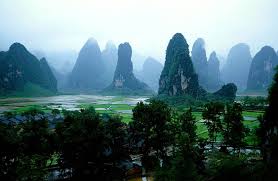
Tower karst
Q1. Calcium bicarbonate is created by the interaction of the substances. What are they?
A plants, magnesium, dolomite
B carbon dioxide, sunlight, and plants
C water, carbon dioxide, and lime
D water, carbon dioxide, and dolomite
E oxygen, water, magnesium bicarbonate
Q2. Where are you likely to find tower karst?
A the U.S. and Canada
B China and Vietnam
C Russia and Iran
D Hawaii and Alaska
E Japan and India
Q3. Geothermal energy as a kind of new energy, which of the following is true?
A Useful minerals can be ʺminedʺ along with hot water.
B It is immune from seismic activity.
C It can be used in home applications.
D Enhanced geothermal system technology can be applied anywhere.
E Large amounts of useful carbon dioxide are released.
Q4. Which of the following is likely to cause the precipitation of lime out of a water solution?
A Photosynthesis in heat-loving algae
B Rain falling out of clouds
C Reduction of temperature and pressure
D Water squeezed into rock joints
E Sublimation of liquid water
Q5. What are the three necessary ingredients for hydrothermal activity?
A molten material close to the surface, broken rock material close to the surface, and plentiful precipitation.
B steep slopes, broken rock material close to the surface, and plentiful precipitation.
C much limestone, steep slopes, and acidic groundwater
D relatively high altitude, broken rock material close to the surface, and acidic groundwater.
Q6. If differential erosion exist a region, which of the following is true?
A It is likely to be a humid region with minimal weathering.
B It is likely to be a humid region of sandstone rocks.
C It is likely to be an arid region of massive igneous rocks.
D It is likely to be an arid region of multiple sedimentary layers.
Q7. Which of the following is true about most desert streamflows?
A They usually evaporate or seep into the landscape.
B They usually run to the sea.
C They usually flow into an exotic stream.
D They usually are perennial.
E They usually end many weeks after a rain.
Q8. Which of the following does NOT belong on the list?
A Deflation
B Blowout
C Saltation
D Abrasion
Q9. In a typical basin-and-range terrain, which one of the following landforms is found at the lowest elevation relative to the others?
A playa
B pediment
C range
D alluvial fan
Q10. Which one of the following does NOT belong with the others?
A plateau
B butte
C pinnacle
D mesa
E playa
Q11. Which of the following is likely to be found in mesa-and-scarp topography?
A Folding
B Soil creep
C Vivid color
D A high average annual rainfall total
E Erosion of igneous rocks
Q12. Which of the following does NOT belong with the others?
A Anauatak
B kame
C Moraine
D drumlin
E Esker
Q13. Which of the following is in the wrong spatial order with the others?
A terminal moraine
B accumulation zone
C equilibrium line
D ablation zones
Q14. Tarn is associated with which of the following?
A knickpoint
B moraine
C erratic
D cirque
E arête
Q15. Which of the following does not affect the glacial erosion?
A periglacial conditions
B thickness of the ice
C rate of ice flow
D roughness of terrain
E bedrock structure
Q16. A wave just passed a buoy in the middle of the ocean. How would the buoy move?
A It would move in the direction opposite to that of the wave
B It would move first in the direction of the wave and then in the direction opposite to that of the wave
C It would move in the direction of the wave
D It would move up and down
E It would move at right angles to the wave motion
Q17. Which of the following is likely to break a wave?
A the wind increases its speed near shorelines
B random molecular motion in wave forms
C the bottom interferes with its oscillatory motion
D the sediment load of water is greater near the shore
E the density of water increases closer to shore
Q18. Which of the following statement is true?
A Longshore currents transport sand.
B Rising sea level creates barrier islands.
C Submergence of shoreline creates cliffs.
D Tides always have significant erosion.
Q19. Which one of the following is related to the volume change of ocean water?
B Gravitational forces
C Tidal forces
D Tectonic forces
E Erosional forces
Q20. Which of the following is true?
A When waves of translation move from deep water to shallow water near the coast, they change shapes and become waves of oscillation.
B Wave shape changes usually occur in zones near the coast rather than in open water.
C Most waves approach the coast parallel to the coast.
D Barrier reef is the most advanced stage of tropical reef formation.
We can write this or a similar paper for you! Simply fill the order form!




